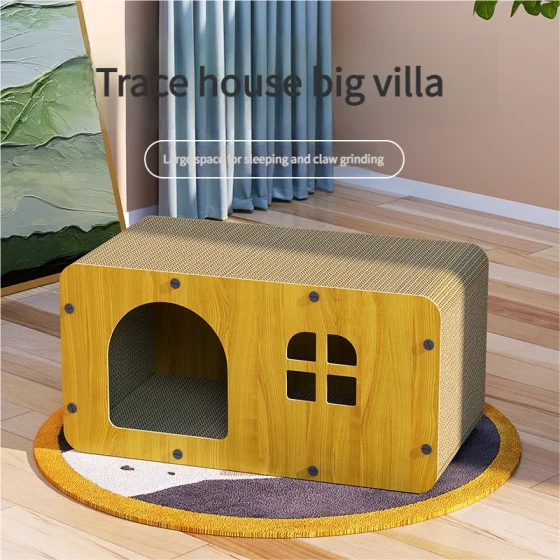Does It Need Intervention When New Cat and Old Cat Fight_5 Tips to Properly Handle Cat Conflicts
When you bring a new cat home and let it meet the “resident” old cat, fights may break out between them. Many novice cat owners get very nervous seeing this and don’t know whether to intervene immediately or let them resolve it on their own. In fact, it is very important to distinguish whether the cats are playing or really fighting, and for real conflicts, proper and appropriate intervention is necessary—you cannot completely ignore it, nor should you intervene crudely.

There are many reasons why cats fight, the most common being territorial and resource conflicts. Cats are territorial animals and have a strong sense of protection over their territory. The arrival of a new cat is seen by the old cat as an “intruder,” triggering conflicts. Also, competition for food, water, toys, litter boxes, or even environmental changes and unfamiliar scents can cause tension and even fights between cats. Sometimes, cats display redirect aggression, for example, seeing another cat outside the window that they cannot “punish” and instead attack the cat nearby.
Distinguishing whether cats are playing or truly fighting mainly depends on their body language, sounds, and interaction patterns.
- Body Language: When playing, cats’ bodies are generally relaxed, ears may face forward or upwards, tails swing naturally or held high, claws are usually retracted, and bites are controlled in force. In a real fight, cats’ bodies become stiff and tense, ears flatten back, fur may puff up (piloerection), tails may lash quickly or tuck underneath, pupils dilate, claws extend, and they may hiss, growl, roar, or scream. If one cat tries to escape or hide while the other relentlessly chases, this is usually a sign of a real fight.
- Sounds: Sounds during play are usually light, like happy “meows” or gentle purring. During fights, cats make obvious negative sounds like hissing (threat or fear), low growls (warnings), or screaming (pain or fear).
- Interaction Patterns: Play is usually interactive, cats take turns chasing and pouncing, and roles switch. If one cat always attacks the other, or one consistently avoids, it’s more likely a real fight. Play usually involves short breaks during which cats may rest or readjust positions.
5 Tips to Properly Handle Cat Conflicts
Since completely letting cats “fight it out” is not advisable (because it can worsen negative relations or even cause injuries and long-term animosity), how should we correctly handle conflicts between new and old cats?
1. Immediately and Safely Stop the Conflict:
Once it’s confirmed that cats are really fighting and not playing, intervention is needed immediately. Remember, do not try to separate fighting cats with your bare hands as you can easily get hurt, and the cats might turn their aggression on you.
The correct way is to use some tools or methods to interrupt them:
- Create Noise: Sudden loud noises—like clapping, whistle blowing, or shaking a small coin-filled container—can instantly grab their attention and make them stop.
- Use Obstacles: Inserting a cardboard, pillow, blanket, or even spraying with a water gun between the cats can effectively separate them.
2. Isolate the Conflicting Cats:
Separate fighting cats and keep them in different rooms to give them time and space to calm down. During isolation, ensure each has its own food, water, litter box, and comfortable resting area. The length of isolation depends on the severity of the conflict and the cats’ stress responses, which might take hours or even days.
3. Slowly and Gradually Reintroduce:
If the first encounter between new and old cats resulted in conflict, it means that the introduction was probably too fast. Return to the “beginner stage” and start with slow, staged introductions, requiring patience.
- Scent Exchange: During isolation, exchange items with each cat’s scent (like blankets or toys) so they get familiar with each other’s presence. During feeding, place the item scented with the other’s smell near the food bowl, helping associate the scent with positive things (food).
- Visual Contact: After they adapt to each other’s scent, allow them to see each other behind barriers (like baby gates, screen doors, or glass doors) without physical contact. During this time, feed or play with them separated by the barrier to create positive interactions.
- Limited Contact: When cats can eat and play calmly with the barrier separating them, without obvious aggression or fear, under owner supervision, allow short direct contact in the same space. Start with brief interactions and gradually increase time as their relationship improves.
4. Provide Plenty of Resources and Vertical Space:
Resource shortage is a major cause of cat conflicts. Ensure your cats have enough food bowls, water bowls, litter boxes, scratching posts, toys, and resting areas. It’s usually recommended to have the number of litter boxes as “number of cats +1,” placed in different locations to prevent one cat from monopolizing the resources.
Additionally, cats like high places; vertical space helps them feel safer and offers spots to hide or observe. Setting up cat trees, wall shelves, etc., can effectively reduce tension between cats.
5. Seek Professional Help:
If you have tried various methods but conflicts remain frequent or severe, causing injury or stress behaviors (like inappropriate urination, excessive grooming, hiding), it’s time to consult a professional cat behaviorist. They can tailor a professional behavior modification plan to your cats’ specific situation. Vets can also rule out underlying health problems causing aggression.
Remember, building a harmonious multi-cat household takes time and patience. Every cat’s personality and adaptability vary. Don’t force them to become friends immediately; guide them step by step, create a positive interactive environment, and most cats will learn to coexist peacefully, even forming deep bonds.
Frequently Asked Questions
-
Will cats stop fighting on their own?
True cat fights won’t just resolve themselves by “fighting it out,” which can worsen negative feelings, damage relationships, and cause physical or psychological harm. Owner intervention and guidance are very important.
* How to tell if cats are playing or fighting?Observe their body language (ears, tail, fur), sounds (whether they hiss or scream), and interaction patterns (whether they take turns chasing and pouncing, or one is consistently avoiding). Play is usually relaxed with soft sounds; fighting features stiff bodies and loud negative sounds.
* How long does introducing new and old cats take?There is no fixed time; it depends on cats’ personalities and adaptability and may take days, weeks, or months. The key is to observe cats’ conditions, not rush, and strictly follow staged introduction steps.
* Is punishing cats effective to stop fights?It is not recommended to punish aggressive behavior, as it may increase fear or resistance and worsen the situation. Use positive methods like eliminating conflict sources, staged introductions, and providing resources.
References:
- Cats and Fighting | Prevent Fighting - Cats Protection
- Aggression Between Cats in Your Household - ASPCA
- How to tell if your cats are playing or fighting? | Apex Vets
- Cat Behavior︱How to Harmoniously Introduce a New Cat to the Old Owner? - Orange Circle Cat
- The Dos and Don'ts of Breaking Up a Cat Fight - Pets Best Insurance
- Are my Cats Playing or Fighting? How can you Tell? - Feliway
- How do I know if resident cat is accepting new kitten? : r/CatAdvice - Reddit
- How do I introduce my new cat to my old cat? - BC SPCA
- How to Manage Fighting and Aggression Between Cats - WebMD
- How To Safely Stop A Cat Fight - Class Act Cats
- Are My Cats Playing or Fighting? | Comfort Zone
- 10 Serious Warning Signs When Introducing Cats
- Playing or Fighting: The Basics : r/CatTraining - Reddit
- Can You Tell If Two Cats Are “Fighting” or Just Playing? - Sina
- Difference Between Cat Fighting and Playing: How to Recognize Cat Behavior?_Cat Care Knowledge - Pet Cats
- Please help - Introducing a new cat to a current cat is not working. Constant stalking and violence : r/CatAdvice - Reddit
- 【Science Popularization】Several Unnoticeable Conflicts in Multi-Cat Families - Group Discussion - Douban
- It’s Simple to Tell if Cats Are Really Fighting, There Are Signals Before Cats Fight! - NetEase
- Feline Behavior Problems: Aggression | Cornell University College of Veterinary Medicine
- What to Do When New Cat Fights Old Cat? - Himalaya Mobile
- Cat Conflict Imminent! Expert Reveals “3 Abnormal Interactions in Multi-Cat Homes” to Intervene Quickly: They Are Going to Fight | United Daily News
- How to Help New and Old Cats Get Along? Cat Talk Society Teaches 5-Stage "Separation and Introduction"
- 3 Ways to Determine If Cats Are Playing or Fighting - wikiHow
- 【What to Do About Cat Fights】Prevent Cat Fighting + Emergency Mediation Guide for Multi-Cat Families - Fur Children Park
- How Long Does It Take New and Old Cats to Get Along? Immediate Meeting Leads to Fighting? Essential Guide to Peaceful Coexistence When Getting a Second Cat - Wang Meow Planet



